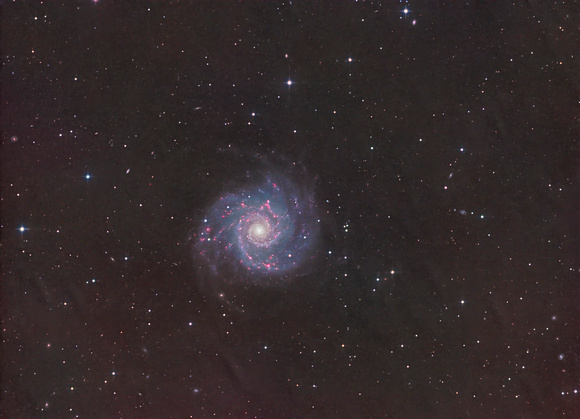M74 "Grand Design" Galaxy in LHaRGB
M74 “Grand Design” Galaxy in LHaRGB (Pisces)
Planewave CDK12.5; AP 1100GTO AE
ASI6200MM, - Antlia Pro RGB & 3.5nm NB filters
Ha: (23 x 450s exposures, Bin 1x1, Gain 200)
R,G,B: (25,29,27 x 240s, Bin 1x1, Gain 100)
L: : (52 x 210s exposures, Bin 1x1, Gain 100)
Total Integration Time = 11.3 hours – Sep/Oct 2023
M74 in Pisces is deemed the archetypal dual-armed “Grand Design” spiral galaxy. In addition, it also presents to us fully face on, and as a result, is studied considerably for the spiral structure. Unfortunately, the surface brightness is not high (mag 9.4) and while large, it the most difficult Messier object to observe.
M74 contains 100 billion stars, somewhat less than our Milky Way, but is physically larger (95,000 lys vs 84,000) and is 30 Million lys away or more that 10 times more distant than the Andromeda Galaxy. This galaxy is also fairly active, as indicated by the many red Ha emitting regions throughout the spiral arms. The arms are also quite blue, indicating the predominance of newer stars. Three supernova have been recorded in M74 in the last 25 years also suggesting the formation of large young blue stars with shorter lifespans. Only very near the core of the galaxy are older, yellower stars noted.
Rather than zooming in and cropping on the galaxy, I left the image wide, to capture the many smaller/more distant galaxies that I managed to capture. There was also a hint of Interstellar Flux Nebula (or background dust), but I would require much more integration time to show it more clearly.
Just my own thoughts on the spiral arms….As far as the spiral structure is concerned – the current theory is that these are the result of “spiral density waves”, but personally I am unconvinced. I am not sure why the literature does not address the apparent viscosity and fluid dynamic effects that may cause the creation of spiral arms. Unfortunately, we are unable to measure the ultra-low viscosity of materials under ultra-low density down here on earth. An apparent viscosity would account from electrodynamic interactions such as Van der Wahl forces rather than “self gravity”. In addition, such a solution to the problem would require a finite-difference PDE solver to model the molecular clouds in addition to the standard multi-body simulations for stars. It sure looks like water going down a drain though.


